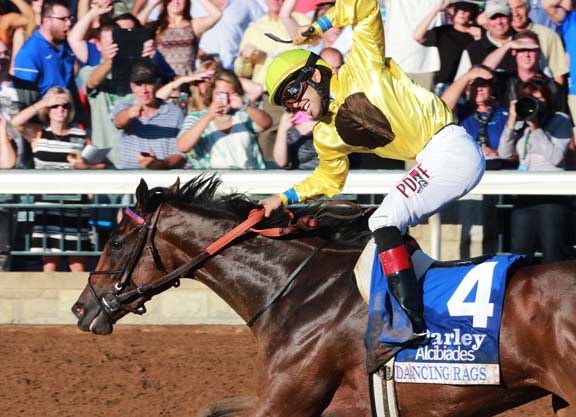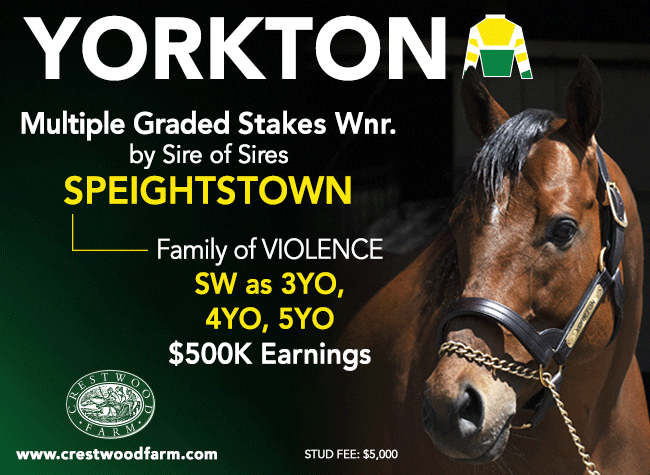By Jessica Martini
When Dancing Rags (Union Rags) crossed the finish line first in the Oct. 7 GI Darley Alcibiades S., she not only gave Maryland breeder David DiPietro his first Grade I winner, but also provided a timely update for her Tiznow half-brother who will sell at the upcoming Fasig-Tipton October Fall Yearlings Sale in Lexington.
“It was very exciting–I've bred a couple of stakes winners, but this was my first Grade I winner,” DiPietro said, before admitting he was forced to celebrate the career highlight completely on his own.
“I was at my business school reunion in New Hampshire, I was by myself and I flipped on TVG just in time to watch the race,” he laughed. “I was with a whole group of people later who had no idea about horse racing at all, so I had absolutely zero people to talk to about it with until I got back to Maryland on Sunday. But it was a thrill nonetheless.”
DiPietro, a former senior executive of Deutsche Bank and former president of the investment banking firm Signal Hill, followed racing from a young age before partnering with fellow racing enthusiast George Bolton on his first racehorse.
“I always had an interest in it as a kid,” DiPietro said. “I grew up in Maryland and would go to the Preakness every year. My aunt worked at Pimlico part time as an accountant, so I would follow it and watch the big races on television. Then when I was in my business career, I got connected to George Bolton, who was a good friend and a co-worker, and I really got into the business with him. I bought a yearling with him at Saratoga and I've been at it ever since–a lot of times with him and more recently I've done a fair amount on my own.”
A member of the board of Maryland Horse Breeders Association and a former president of the Maryland Million Ltd., DiPietro currently has five broodmares–two based in Kentucky and three in Maryland.
“I'll keep a couple of horses in training in Maryland and I have one horse in training in Kentucky,” DiPietro explained. “But the primary focus for me is really to breed and to sell.”
Even the horse in training in Kentucky was bought with an eye towards a future broodmare career.
“I actually bought her as a broodmare prospect as a yearling just because I really liked her,” he said. “I work pretty closely with [bloodstock agent] Larkin Armstrong and we were talking about it and decided we would take that approach for this one and so she is in training, but was really purchased with the idea of having her be a broodmare at some point down the road.”
It was Armstrong's name on the ticket when DiPietro purchased Dancing Rags's dam Home Court (Storm Cat) for $110,000 at the 2012 Keeneland November sale. The then-11-year-old mare, who had sold for $1.4 million at the 2005 Keeneland November sale, was in foal to Lookin at Lucky at the time and the two men saw nothing but upside in the purchase.
Graded stakes placed on the track, Home Court is a daughter of champion Jewel Princess (Key to the Mint). Just months before the November sale, her Tapit yearling sold for $300,000 at the Keeneland September sale. That colt went on to be 2014 GII Amsterdam S. winner and GI King's Bishop third-place finisher Coup de Grace.
“I'm not a swing-for-the-fences kind of player in this business, I try to be pragmatic,” DiPietro explained. “Home Court was an incredibly well-bred mare who had sold off-the-track for $1.4 million. She had been bred to some very good stallions, for sure, and without any really big horses coming out of that. So I think people grew a little leery of her. She was in foal to Lookin at Lucky and we just felt like if we could get her for that price and in foal to a first-year stallion who might be popular, that we would have pretty limited downside. We both loved the pedigree and her yearlings had all sold really well, so we were pretty confident that we would probably do reasonably well with her without any huge expectations. It was just a really good value at the time and we loved the pedigree and she was a nice-looking mare who threw nice-looking foals.”
The decision to send Home Court to GI Belmont S. winner Union Rags was based largely on their physical match-ups.
“The one thing about Home Court, with the matings we were, and still always are, trying to put a little more leg onto her,” DiPietro commented. “She is a little shorter and so we thought Union Rags fit that bill nicely. We tried to breed her back to Will Take Charge last year and we loved the physical match there. And then we went to Tiznow for some of the same reasons–an established sire who might throw a good physical. That was sort of the thinking in terms of the physical match and Larkin has been great at keeping his eyes out for horses that suit her.”
Dancing Rags sold for $80,000 at last year's Keeneland September sale before bringing $210,000 from Chadds Ford Stable at this year's OBS March sale.
“There were a lot of Union Ragses in the Keeneland catalogue last year and I would say that I think our strategy was sound, but she ended up not being as big as a lot of the other Union Ragses,” DiPietro recalled. “He didn't really stamp himself as much on her as he did on some of the other horses in the sale and I think we suffered a little bit as a consequence. She was a beautiful filly, very well put-together, but being in the first book, I think the bar is so high and there were so many other ones to choose from, that despite Coup de Grace's success, we thought we would do really well, but I think maybe she wasn't exactly the physical type that the buyers were looking for, particularly relative to other Union Ragses that were available. I was a little bit disappointed at what she brought, but I had made up my mind to let her go and hopefully she would end up in good hands where she would help the mare out.”
Dancing Rags had made only one start for Chadds Ford and trainer Graham Motion, a third-place finish in an Aug. 5 Laurel maiden, when her yearling half-brother by Tiznow made his first appearance in the sales ring at last month's Keeneland September sale. The youngster was led out unsold at $70,000.
“I think we were all–one of the people involved used the word speechless–at what happened when he went in the ring [at Keeneland],” DiPietro admitted. “There was so much pre-sale interest and activity and vet work and re-looks, so we thought we were in pretty good shape and well, well north of what happened in the ring. I wasn't there, but it seemed like the sale started off kind of funny–it seemed to get stronger as it went on. So I think it was one of those things where we just fell through the cracks because there were no specific knocks on the horse. He's a big, flashy, strapping colt who vets really well. The buyers on that day were maybe looking for something different and we didn't want to let him go.”
The yearling will return to the sales ring on the third and final day of the Fasig October sale, which runs from Oct. 24 through 26, as hip 1237 through the Lane's End consignment.
“I wasn't interested in selling him for that price [at Keeneland], but hopefully now he'll get a little more attention and there really isn't much to knock him for,” DiPietro said. “I'm hoping he'll get a lot more interest, particularly with the update.”
As a native Marylander, DiPietro has plenty to be excited about as the state continues its racing renaissance.
“We are very excited down here,” he confirmed. “We went through a lot of tough years and we lost a lot of momentum, but the numbers have started to turn up and some nice new stallions have come into the state. The owner and breeder program, which really rivals the best programs out there right now, has made a significant difference. It's been very lucrative to the active breeders.”
He continued, “And of course, our purse structure has improved and it's attracted quite a bit of interest from trainers outside of the state, so the racing has gotten meaningfully more competitive. Being as close as we are to Fair Hill [Training Center], we are getting a lot of entries from a number of great trainers who are based there. So I actually think with these maiden races down here at $40,000 plus a very good bonus program, breaking your maiden at Laurel is actually quite good because the competition is pretty stiff. Dancing Rags may have been one of only a handful of horses who were Maryland-bred in her maiden race, so there are quite a bit of people shipping in and running here. The other thing that has been great is the facilities that the owners have started to pump a lot of money into, particularly Laurel and hopefully Pimlico down the road. So it has made it a more pleasant experience to go the races. I hope it lasts. Things can be pretty volatile in this business, but I think for now, we are trying to capitalize on it and sustain it for as far into the future as we can.”
Not a subscriber? Click here to sign up for the daily PDF or alerts.






